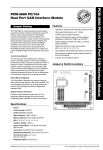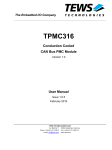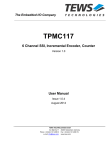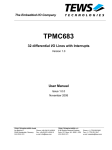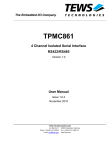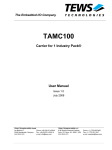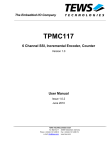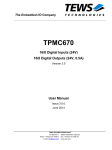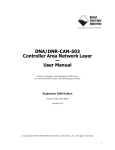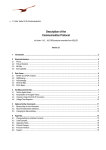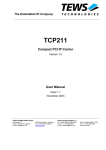Download TPMC810 - powerbridge.de
Transcript
The Embedded I/O Company TPMC810 Isolated 2x CAN Bus Version 1.1 User Manual Issue 1.3 April 2004 D76810800 TEWS TECHNOLOGIES GmbH Am Bahnhof 7 Phone: +49-(0)4101-4058-0 e-mail: [email protected] 25469 Halstenbek / Germany Fax: +49-(0)4101-4058-19 www.tews.com TEWS TECHNOLOGIES LLC 1 E. Liberty Street, Sixth Floor Phone: +1 (775) 686 6077 e-mail: [email protected] Reno, Nevada 89504 / USA Fax: +1 (775) 686 6024 www.tews.com TPMC810-10 Isolated 2x CAN bus, 2x DB9 front panel connector, P14 Back I/O This document contains information, which is proprietary to TEWS TECHNOLOGIES GmbH. Any reproduction without written permission is forbidden. TEWS TECHNOLOGIES GmbH has made any effort to ensure that this manual is accurate and complete. However TEWS TECHNOLOGIES GmbH reserves the right to change the product described in this document at any time without notice. TEWS TECHNOLOGIES GmbH is not liable for any damage arising out of the application or use of the device described herein. Style Conventions Hexadecimal characters are specified with prefix 0x, i.e. 0x029E (that means hexadecimal value 029E). For signals on hardware products, an ‚Active Low’ is represented by the signal name with # following, i.e. IP_RESET#. Access terms are described as: W Write Only R Read Only R/W Read/Write R/C Read/Clear R/S Read/Set 2003 by TEWS TECHNOLOGIES GmbH Issue Description Date 1.0 First Issue January 2003 1.1 Correction “Configuration EEPROM” April 2003 1.2 Correction “Configuration EEPROM” September 2003 1.3 Weight Added and Version April 2004 TPMC810 User Manual Issue 1.3 Page 2 of 22 Table of Contents 1 2 3 PRODUCT DESCRIPTION ......................................................................................... 5 TECHNICAL SPECIFICATION................................................................................... 6 LOCAL SPACE ADDRESSING.................................................................................. 7 3.1 PCI9030 Local Space Configuration .............................................................................................7 3.2 CAN Controller Register Address Space......................................................................................8 3.2.1 SJA1000 CAN Controller Registers......................................................................................8 4 PCI9030 TARGET CHIP........................................................................................... 11 4.1 PCI Configuration Registers (PCR) .............................................................................................11 4.1.1 PCI9030 Header .................................................................................................................11 4.1.2 PCI Base Address Initialization ..........................................................................................12 4.2 Local Configuration Register (LCR)............................................................................................13 4.3 Configuration EEPROM ................................................................................................................14 4.4 Local Software Reset....................................................................................................................15 5 PROGRAMMING HINTS .......................................................................................... 16 5.1 SJA1000 CAN Controller ..............................................................................................................16 6 CONFIGURATION HINTS ........................................................................................ 19 6.1 Transceiver Silent Mode...............................................................................................................19 6.2 DIP Switch Settings ......................................................................................................................20 7 PIN ASSIGNMENT – I/O CONNECTOR .................................................................. 21 7.1 Front Panel I/O...............................................................................................................................21 7.2 Back I/O P14 ..................................................................................................................................22 TPMC810 User Manual Issue 1.3 Page 3 of 22 Table of Figures FIGURE 1-1 : BLOCK DIAGRAM......................................................................................................................5 FIGURE 2-1 : TECHNICAL SPECIFICATION...................................................................................................6 FIGURE 3-1 : PCI9030 LOCAL SPACE CONFIGURATION ............................................................................7 FIGURE 3-2 : CAN CONTROLLER REGISTER SPACE..................................................................................8 FIGURE 3-3 : REGISTERS OF SJA1000 .........................................................................................................9 FIGURE 4-1 : PCI9030 HEADER....................................................................................................................11 FIGURE 4-2 : PCI9030 PLD BASE ADDRESS USAGE.................................................................................12 FIGURE 4-3 : PCI9030 LOCAL CONFIGURATION REGISTER ....................................................................13 FIGURE 4-4 : CONFIGURATION EEPROM TPMC810-10 ............................................................................14 FIGURE 5-1 : OUTPUT CONTROL REGISTER (OCR; 0X08).......................................................................16 FIGURE 5-2 : CLOCK DIVIDER REGISTER (CDR; 0X1F) ............................................................................17 FIGURE 5-3 : RX- AND TX-BUFFER IN BASICCAN MODE..........................................................................17 FIGURE 5-4 : RX- AND TX-BUFFER IN PELICAN MODE.............................................................................18 FIGURE 6-1 : TRANSCEIVER SILENT MODE SETTINGS ...........................................................................19 FIGURE 6-2 : DIP SWITCH SETTINGS .........................................................................................................20 FIGURE 6-3 : CAN CHANNEL INTERFACE ..................................................................................................20 FIGURE 7-1 : DB9 MALE CONNECTOR X1 CHANNEL 1.............................................................................21 FIGURE 7-2 : DB9 MALE CONNECTOR X2 CHANNEL 2.............................................................................21 FIGURE 7-3 : PIN ASSIGNMENT P14 BACK I/O CONNECTOR ..................................................................22 TPMC810 User Manual Issue 1.3 Page 4 of 22 1 Product Description The TPMC810 is a standard single-width 32 bit PMC with two independent CAN bus channels, isolated from system logic and from each other. Two Philips SJA1000 CAN controllers (CAN specification 2.0B supported) are used. CAN High Speed transceivers are used for the CAN bus I/O interface. An on board termination option (DIP switch) is provided for each CAN bus channel to configure on board termination and pass through mode for the CAN bus. Each channel can generate an interrupt on INTA. The TPMC810 provides front panel I/O via two DB9 male connectors and rear panel I/O via P14. Figure 1-1 : Block Diagram TPMC810 User Manual Issue 1.3 Page 5 of 22 2 Technical Specification PMC Interface Mechanical Interface PCI Mezzanine Card (PMC) Interface Single Size Electrical Interface PCI Rev. 2.1 compliant 33 MHz / 32 bit PCI 3.3V and 5V PCI Signaling Voltage On Board Devices PCI Target Chip PCI9030 (PLX Technology) CAN Controller 2 x SJA1000 @ 16MHz (Philips) CAN Transceiver 2 x TJA1050 (Philips) I/O Interface Number of CAN Bus Channels 2 (Isolated against each other) CAN Bus Interface CAN High Speed (11898-2) I/O Connector PMC P14 I/O (64 pin Mezzanine Connector) 2 x DB9 front panel connector Physical Data Power Requirements 150mA typical @ +3.3V DC 330mA typical @ +5V DC Temperature Range Operating Storage MTBF 404276h Humidity 5 – 95 % non-condensing Weight 76g -40°C to +85°C -40°C to +125°C Figure 2-1 : Technical Specification TPMC810 User Manual Issue 1.3 Page 6 of 22 3 Local Space Addressing 3.1 PCI9030 Local Space Configuration The local on board addressable regions are accessed from the PCI side by using the PCI9030 local spaces. PCI PCI9030 PCI9030 Space Local PCI Base Address Mapping Space (Offset in PCI Configuration Space) Size (Byte) Port Width (Bit) Endian Mode Description 0 2 (0x18) MEM 512 8 BIG CAN Controller Address Space 1 3 (0x1C) - - - - Not Used 2 4 (0x20) - - - - Not Used 3 5 (0x24) - - - - Not Used Figure 3-1 : PCI9030 Local Space Configuration TPMC810 User Manual Issue 1.3 Page 7 of 22 3.2 CAN Controller Register Address Space PCI Base Address: PCI9030 PCI Base Address 2 (Offset 0x18 in PCI Configuration Space) CAN CONTROLLER REGISTER SPACE Offset to PCI Base Address 3 Register Name Size (Bit) CAN Controller Channel 1 0x000 CAN Controller CH1 Address 0 8 0x001 CAN Controller CH1 Address 1 8 0x002 CAN Controller CH1 Address 2 8 … … … 0x07F CAN Controller CH1 Address 127 8 0x080 … 0x0FF Reserved - CAN Controller Channel 2 0x100 CAN Controller CH2 Address 0 8 0x101 CAN Controller CH2 Address 1 8 0x102 CAN Controller CH2 Address 2 8 … … … 0x17F CAN Controller CH2 Address 127 8 0x180 … 0x1FF Reserved - Figure 3-2 : CAN Controller Register Space 3.2.1 SJA1000 CAN Controller Registers The SJA1000 is controlled via a set of registers (control segment) and a RAM (message buffer). The following table “Registers of the SJA1000” lists these registers grouped according to their usage in a system, the addresses are decimal values. Note that some registers are available in PeliCAN Mode only and that the Control Register is available in BasicCAN Mode only. Furthermore some registers are read only or write only and some can be accessed during Reset Mode only. More information about the registers with respect to read and/or write access, bit definition and reset values, can be found in the data sheet SJA1000 (http://www.semiconductors.philips.com). See also chapter “Programming Hints” for some general register settings. TPMC810 User Manual Issue 1.3 Page 8 of 22 Register Address: (decimal) PeliCAN Mode BasicCAN Mode (MOD) 0 — Sleep-, Acceptance Filter-, Self Test-, Listen Only- and Reset Mode selection (CR) — 0 Reset Mode selection in BasicCAN Mode Command (CMR) –– 1 Sleep Mode command in BasicCAN Mode Clock Divider (CDR) 31 31 Set-up of clock signal at CLKOUT (pin 7) selection of PeliCAN Mode, Comparator Bypass Mode, TX1 (pin 14) Output Mode Acceptance Code, Mask (ACR) (AMR) 16-19 20-23 4, 5 Selection of bit patterns for Acceptance Filtering Elements for setting up Bus Timing 0 the CAN 1 communication (BTR0) (BTR1) 6 7 6 7 Set-up of Bit Timing Parameters Output Control (OCR) 8 8 Selection of Output Driver properties Command (CMR) 1 1 Commands for Self Reception, Clear Data Overrun, Release Receive Buffer, Abort Transmission and Transmission Request (SR) 2 2 Status of message buffers, status of CAN Core Block (IR) 3 3 CAN Interrupt flags Interrupt Enable (IER) 4 — Enable/disable of interrupt events in PeliCAN Mode Control (CR) — 0 Enable/disable of interrupt events in BasicCAN Mode Type of Usage Register Name Mode Control Elements for selecting different operation modes Basic elements for the CAN communication Status Interrupt (Symbol) Functionality Figure 3-3 : Registers of SJA1000 TPMC810 User Manual Issue 1.3 Page 9 of 22 Register Address: (decimal) Type of Usage Elements for a comprehensive error detection and analyzing Message buffers Register Name (Symbol) PeliCAN Mode BasicCAN Mode Functionality Arbitration Lost Capture (ALC) 11 — Shows bit position, where arbitration was lost Error Code Capture (ECC) 12 — Shows last error type and location Error Warning Limit (EWLR) 13 — Selection of threshold for generating an Error Warning Interrupt RX Error Counter (RXERR) 14 — Reflects the current value of the Receive Error Counter TX Error Counter (TXERR) 14, 15 — Reflects the current value of the Transmit Error Counter Rx Message Counter (RMC) 29 — Number of messages in the Receive FIFO Rx Buffer Start Addr. (RBSA) 30 — Shows the current internal RAM address of the message available in the Receive Buffer Transmit Buffer (TXBUF) 16-28 10-19 Receive Buffer (RXBUF) 16-28 20-29 Figure 3-3 : Registers of the SJA1000 (cont.) TPMC810 User Manual Issue 1.3 Page 10 of 22 4 PCI9030 Target Chip 4.1 PCI Configuration Registers (PCR) 4.1.1 PCI9030 Header PCI CFG Register Address 31 Write ‘0’ to all unused (Reserved) bits 24 23 16 15 8 PCI writeable 7 Initial Values (Hex Values) 0 0x00 Device ID Vendor ID N 032A 1498 0x04 Status Command Y 0280 0000 Revision ID N 028000 00 Cache Line Size Y[7:0] 00 00 00 00 0x08 0x0C Class Code BIST Header Type PCI Latency Timer 0x10 PCI Base Address 0 for MEM Mapped Config. Registers Y FFFFFF80 0x14 PCI Base Address 1 for I/O Mapped Config. Registers Y FFFFFF81 0x18 PCI Base Address 2 for Local Address Space 0 Y FFFFFE00 0x1C PCI Base Address 3 for Local Address Space 1 Y 00000000 0x20 PCI Base Address 4 for Local Address Space 2 Y 00000000 0x24 PCI Base Address 5 for Local Address Space 3 Y 00000000 0x28 PCI Cardbus Information Structure Pointer N 00000000 N 000A 1498 Y 00000000 N 000000 40 N 00000000 00 00 01 00 0x2C Subsystem ID 0x30 PCI Base Address for Local Expansion ROM 0x34 Reserved 0x38 0x3C Subsystem Vendor ID Max_Lat 0x40 Min_Gnt PM Cap. 0x44 PM Data PM CSR EXT 0x48 Reserved HS CSR 0x4C New Cap. Ptr. Reserved VPD Address 0x50 Interrupt Pin Interrupt Line Y[7:0] PM Nxt Cap. PM Cap. ID N 4801 00 01 Y 00 00 0000 PM CSR HS Nxt Cap. HS Cap. ID Y[23:16] 00 00 00 06 VPD Nxt Cap. VPD Cap. ID Y[31:16] 0000 00 03 Y 00000000 VPD Data Figure 4-1 : PCI9030 Header TPMC810 User Manual Issue 1.3 Page 11 of 22 4.1.2 PCI Base Address Initialization PCI Base Address Initialization is scope of the PCI host software. PCI9030 PCI Base Address Initialization: 1. Write 0xFFFF_FFFF to the PCI9030 PCI Base Address Register. 2. Read back the PCI9030 PCI Base Address Register. 3. For PCI Base Address Registers 0:5, check bit 0 for PCI Address Space. Bit 0 = '0' requires PCI Memory Space mapping Bit 0 = '1' requires PCI I/O Space mapping For the PCI Expansion ROM Base Address Register, check bit 0 for usage. Bit 0 = ‘0’: Expansion ROM not used Bit 0 = ‘1’: Expansion ROM used 4. For PCI I/O Space mapping, starting at bit location 2, the first bit set determines the size of the required PCI I/O Space size. For PCI Memory Space mapping, starting at bit location 4, the first bit set to '1' determines the size of the required PCI Memory Space size. For PCI Expansion ROM mapping, starting at bit location 11, the first bit set to '1' determines the required PCI Expansion ROM size. For example, if bit 5 of a PCI Base Address Register is detected as the first bit set to ‘1’, the PCI9030 is requesting a 32 byte space (address bits 4:0 are not part of base address decoding). 5. Determine the base address and write the base address to the PCI9030 PCI Base Address Register. For PCI Memory Space mapping the mapped address region must comply with the definition of bits 3:1 of the PCI9030 PCI Base Address Register. After programming the PCI9030 PCI Base Address Registers, the software must enable the PCI9030 for PCI I/O and/or PCI Memory Space access in the PCI9030 PCI Command Register (Offset 0x04). To enable PCI I/O Space access to the PCI9030, set bit 0 to '1'. To enable PCI Memory Space access to the PCI9030, set bit 1 to '1'. Offset in Config. 0x10 Description Usage PCI9030 LCR’s MEM Used 0x14 PCI9030 LCR’s I/O Used 0x18 PCI9030 Local Space 0 Used 0x1C PCI9030 Local Space 1 Not used 0x30 Expansion ROM Not used Figure 4-2 : PCI9030 PLD Base Address Usage TPMC810 User Manual Issue 1.3 Page 12 of 22 4.2 Local Configuration Register (LCR) After reset, the PCI9030 Local Configuration Registers are loaded from the on board serial configuration EEPROM. The PCI base address for the PCI9030 Local Configuration Registers is PCI9030 PCI Base Address 0 (PCI Memory Space) (Offset 0x10 in the PCI9030 PCI Configuration Register Space) or PCI9030 PCI Base Address 1 (PCI I/O Space) (Offset 0x14 in the PCI9030 PCI Configuration Register Space). Do not change hardware dependent bit settings in the PCI9030 Local Configuration Registers. Offset from PCI Base Address Register Value Description 0x00 Local Address Space 0 Range 0x0FFF_FE00 CAN Controller Address Space 0x04 Local Address Space 1 Range 0x0000_0000 0x08 Local Address Space 2 Range 0x0000_0000 0x0C Local Address Space 3 Range 0x0000_0000 0x10 Local Exp. ROM Range 0x0000_0000 0x14 Local Re-map Register Space 0 0x0000_0001 0x18 Local Re-map Register Space 1 0x0000_0000 0x1C Local Re-map Register Space 2 0x0000_0000 0x20 Local Re-map Register Space 3 0x0000_0000 0x24 Local Re-map Register ROM 0x0000_0000 0x28 Local Address Space 0 Descriptor 0x1502_4120 0x2C Local Address Space 1 Descriptor 0x0000_0000 0x30 Local Address Space 2 Descriptor 0x0000_0000 0x34 Local Address Space 3 Descriptor 0x0000_0000 0x38 Local Exp. ROM Descriptor 0x0000_0000 0x3C Chip Select 0 Base Address 0x0000_0081 0x40 Chip Select 1 Base Address 0x0000_0181 0x44 Chip Select 2 Base Address 0x0000_0000 0x48 Chip Select 3 Base Address 0x0000_0000 0x4C Interrupt Control/Status 0x0041 0x4E EEPROM Write Protect Boundary 0x0030 0x50 Miscellaneous Control Register 0x0078_0000 0x54 General Purpose I/O Control 0x0224_96D0 0x70 Hidden1 Power Management data select 0x0000_0000 0x74 Hidden 2 Power Management data scale 0x0000_0000 Figure 4-3 : PCI9030 Local Configuration Register TPMC810 User Manual Issue 1.3 Page 13 of 22 4.3 Configuration EEPROM After power-on or PCI reset, the PCI9030 loads initial configuration register data from the on board configuration EEPROM. The configuration EEPROM contains the following configuration data: • Address 0x00 to 0x27 : PCI9030 PCI Configuration Register Values • Address 0x28 to 0x87 : PCI9030 Local Configuration Register Values • Address 0x88 to 0xFF : Reserved See the PCI9030 manual for more information. Address Offset 0x00 0x02 0x04 0x06 0x08 0x0A 0x0C 0x0E 0x00 0x032A 0x1498 0x0280 0x0000 0x0280 0x0000 0x000A 0x1498 0x10 0x0000 0x0040 0x0000 0x0100 0x4801 0x0001 0x0000 0x0000 0x20 0x0000 0x0006 0x0000 0x0003 0x0FFF 0xFE00 0x0000 0x0000 0x30 0x0000 0x0000 0x0000 0x0000 0x0000 0x0000 0x0000 0x0001 0x40 0x0000 0x0000 0x0000 0x0000 0x0000 0x0000 0x0000 0x0000 0x50 0x1502 0x4120 0x0000 0x0000 0x0000 0x0000 0x0000 0x0000 0x60 0x0000 0x0000 0x0000 0x0081 0x0000 0x0181 0x0000 0x0000 0x70 0x0000 0x0000 0x0030 0x0041 0x0078 0x0000 0x0224 0x96D0 0x80 0x0000 0x0000 0x0000 0x0000 0xFFFF 0xFFFF 0xFFFF 0xFFFF 0x90 0xFFFF 0xFFFF 0xFFFF 0xFFFF 0xFFFF 0xFFFF 0xFFFF 0xFFFF 0xA0 0xFFFF 0xFFFF 0xFFFF 0xFFFF 0xFFFF 0xFFFF 0xFFFF 0xFFFF 0xB0 0xFFFF 0xFFFF 0xFFFF 0xFFFF 0xFFFF 0xFFFF 0xFFFF 0xFFFF 0xC0 0xFFFF 0xFFFF 0xFFFF 0xFFFF 0xFFFF 0xFFFF 0xFFFF 0xFFFF 0xD0 0xFFFF 0xFFFF 0xFFFF 0xFFFF 0xFFFF 0xFFFF 0xFFFF 0xFFFF 0xE0 0xFFFF 0xFFFF 0xFFFF 0xFFFF 0xFFFF 0xFFFF 0xFFFF 0xFFFF 0xF0 0xFFFF 0xFFFF 0xFFFF 0xFFFF 0xFFFF 0xFFFF 0xFFFF 0xFFFF Figure 4-4 : Configuration EEPROM TPMC810-10 TPMC810 User Manual Issue 1.3 Page 14 of 22 4.4 Local Software Reset The PCI9030 Local Reset output LRESETo# is used to reset the on board local logic. The PCI9030 local reset is active during PCI reset or if the PCI adapter software reset bit is set in the PCI9030 local configuration register CNTRL (offset 0x50). CNTRL[30] PCI Adapter Software Reset: Value of ‘1’ resets the PCI9030 and issues a reset to the local bus (LRESETo# asserted). The PCI9030 remains in this reset condition until the PCI host clears this bit. The contents of the PCI9030 PCI and Local Configuration Registers are not reset. The PCI9030 PCI interface is not reset. TPMC810 User Manual Issue 1.3 Page 15 of 22 5 Programming Hints 5.1 SJA1000 CAN Controller The SJA1000 clock input frequency is 16 MHz (for both SJA1000 controllers). See chapter “SJA1000 CAN Controller Registers” for an overview of all registers in the different modes. Note that some registers are available in PeliCAN Mode only and that the Control Register is available in BasicCAN Mode only. Furthermore some registers are read only or write only and some can be accessed during Reset Mode only. A message, which should be transmitted, has to be written to the transmit buffer. After a successful reception the microprocessor may read the received message from the receive buffer and then release it for further use. For register access, two different modes have to be distinguished: • Reset Mode • Operating Mode The Reset Mode (see SJA1000 Control Register (CR; 0x0) for BasicCAN or Mode Register (MOD; 0x0) for PeliCAN, bit Reset Request) is entered automatically after a hardware-reset or when the controller enters the bus-off state (see Status Register, bit Bus Status). The operating mode is activated by resetting of the reset request bit in the control register. More information about the registers with respect to read and/or write access, bit definition and reset values, can be found in the data sheet SJA1000 (http://www.semiconductors.philips.com). The SJA1000 Output Control Register and Clock Divider Register have to be programmed as follows. SJA1000 controllers must be in Reset Mode: Bit Symbol 7 OCTP1 6 OCTN1 5 OCPOL1 4 OCTP0 3 OCTN0 2 OCPOL0 1 OCMODE1 0 OCMODE0 Description 11 : Push-Pull output stage 0: Normal polarity 11 : Push-Pull output stage 0: Normal polarity 01 : Test output mode (bit reflection) 10 : Normal output mode Figure 5-1 : Output Control Register (OCR; 0x08) TPMC810 User Manual Issue 1.3 Page 16 of 22 Bit Symbol Description 7 CAN Mode 6 CBP 5 RXINTEN 4 - 3 clock off 2 CD.2 0 1 CD.1 0 0 CD.0 0 0 : BasicCAN Mode 1 : PeliCAN Mode 1 : Bypass input comparator, use RX0 only 0 : Disable interrupts on TX1 output 0 1 : Disable clock output (not used) Figure 5-2 : Clock Divider Register (CDR; 0x1F) The data to be transmitted on the CAN bus is loaded into the memory area of the SJA1000, called “Transmit Buffer”. The data received from the CAN bus is stored in the memory area of the SJA1000, called “Receive Buffer”. These buffers contain 2, 3 or 5 bytes for the identifier and frame information (dependent on mode and frame type) and up to 8 data bytes. • BasicCAN Mode: The buffers are 10 bytes long (see figure “Rx- and Tx-buffer in BasicCAN Mode”). • PeliCAN Mode: – 2 identifier bytes – up to 8 data bytes The buffers are 13 bytes long (see figure “Rx- and Tx-buffer in PeliCAN Mode”). – 1 byte for frame information – 2 or 4 identifier bytes (Standard Frame or Extended Frame) – up to 8 data bytes Address Name Composition and Remarks Tx-buffer: 0x0A Rx-buffer: 0x14 Identifier Byte 1 8 Identifier bits Tx-buffer: 0x0B Rx-buffer: 0x15 Identifier Byte 2 3 Identifier bits, 1 Remote Transmission Request bit, 4 bits for the Data Length Code, indicating the amount of data bytes Tx-buffer: 0x0C-0x13 Rx-buffer: 0x16-0x1D Data Byte 1 - 8 Up to 8 data bytes as indicated by the Data Length Code Figure 5-3 : Rx- and Tx-buffer in BasicCAN Mode TPMC810 User Manual Issue 1.3 Page 17 of 22 Address Name Composition and Remarks 0x10 Frame Information 0x11, 0x12 Identifier Byte Standard Frame: 11 Identifier bits 1, 2 Extended Frame: 16 Identifier bits 0x13, 0x14 Identifier Byte Extended Frame only: 13 Identifier bits 3, 4 Data Byte Frame type Standard: 0x13 – 0x1A 1 - 8 Extended: 0x15 – 0x1C 1 bit indicating, if the message contains a Standard or Extended frame 1 Remote Transmission Request bit 4 bits for the Data Length Code, indicating the amount of data bytes Up to 8 data bytes as indicated by the Data Length Code Figure 5-4 : Rx- and Tx-buffer in PeliCAN Mode The whole Receive FIFO (64 bytes) can be accessed using the CAN addresses 32 to 95. A read access of the Tx-buffer can be done using the CAN addresses 96 to 108. TPMC810 User Manual Issue 1.3 Page 18 of 22 6 Configuration Hints 6.1 Transceiver Silent Mode The CAN transceivers can be switched to Silent Mode, in this mode the transmitter is disabled. Pin S of the TJA1050 CAN transceivers is directly controlled by a GPIO output of the PCI9030, GPIO1 for channel 1 and GPIO8 for channel 2. The level on the GPIO lines can be changed by setting bit 5 (GPIO1) or bit 26 (GPIO8) in the GPIO Control Register (offset 0x54): Value of GPIO1/8 Data Function 0 Transceiver is in high-speed mode, which is the normal operating mode 1 Transceiver is in silent mode, transmitter is disabled Figure 6-1 : Transceiver Silent Mode Settings Default value after power on is ‘0’ (operating mode). TPMC810 User Manual Issue 1.3 Page 19 of 22 6.2 DIP Switch Settings The following two figures show the DIP switch settings for one CAN channel. Possible line configuration options for each channel are: • On board Line Termination: on / off • P14 Bus Mode : connected / not connected and pass through on / off The on board termination option for a CAN channel node input (see P14 I/O pin assignment) is a 120 ohms split termination network. For the pass through option, the I/O lines are passed through from the node input pins to the node output pins of the P14 I/O connector (see P14 Back I/O pin assignment). Switch-Numbers Function Description 1,2 Line Termination ON: 120 R line termination enabled OFF: Line termination disabled 3,4 P14 Connection ON: Incoming CAN bus connection enabled OFF: Incoming CAN bus connection disabled 5,6 P14 Pass Through ON: Outgoing CAN bus connection enabled OFF: Outgoing CAN bus connection disabled Figure 6-2 : DIP Switch Settings Figure 6-3 : CAN Channel Interface TPMC810 User Manual Issue 1.3 Page 20 of 22 7 Pin Assignment – I/O Connector 7.1 Front Panel I/O Pin Signal 1 N.C. 2 LOW level CAN bus signal 3 Ground channel 1 4 N.C. 5 N.C. 6 Ground channel 1 7 HIGH level CAN bus signal 8 N.C. 9 N.C. Figure 7-1 : DB9 Male Connector X1 Channel 1 Pin Signal 1 N.C. 2 LOW level CAN bus signal 3 Ground channel 2 4 N.C. 5 N.C. 6 Ground channel 2 7 HIGH level CAN bus signal 8 N.C. 9 N.C. Figure 7-2 : DB9 Male Connector X2 Channel 2 TPMC810 User Manual Issue 1.3 Page 21 of 22 7.2 Back I/O P14 Pin Signal 1 N.C. 2 Ground channel 1 3 LOW level CAN bus signal IN channel 1 4 HIGH level CAN bus signal IN channel 1 5 Ground channel 1 6 Ground channel 1 7 LOW level CAN bus signal OUT channel 1 8 HIGH level CAN bus signal OUT channel 1 9 N.C. 10 N.C. 11 N.C. 12 N.C. 13 N.C. 14 N.C. 15 N.C. 16 Ground channel 2 17 LOW level CAN bus signal IN channel 2 18 HIGH level CAN bus signal IN channel 2 19 Ground channel 2 20 Ground channel 2 21 LOW level CAN bus signal OUT channel 2 22 HIGH level CAN bus signal OUT channel 2 23 Ground channel 2 24 ... 64 N.C. Figure 7-3 : Pin Assignment P14 Back I/O Connector TPMC810 User Manual Issue 1.3 Page 22 of 22

























